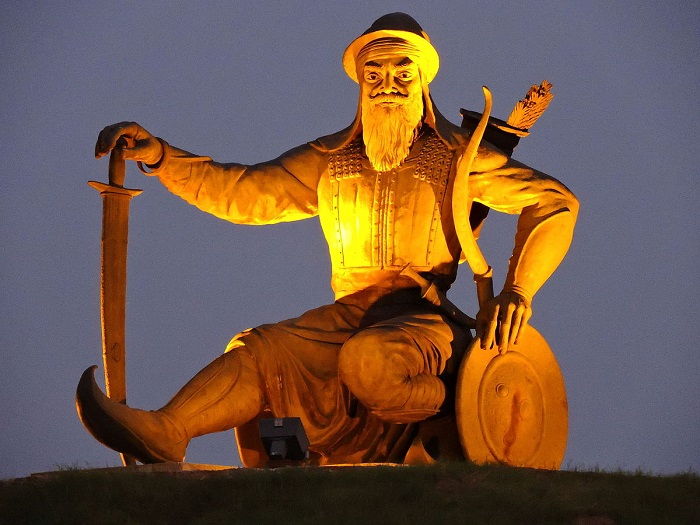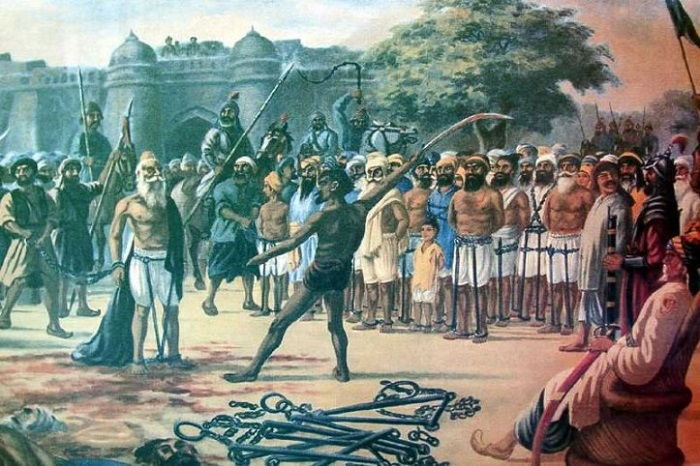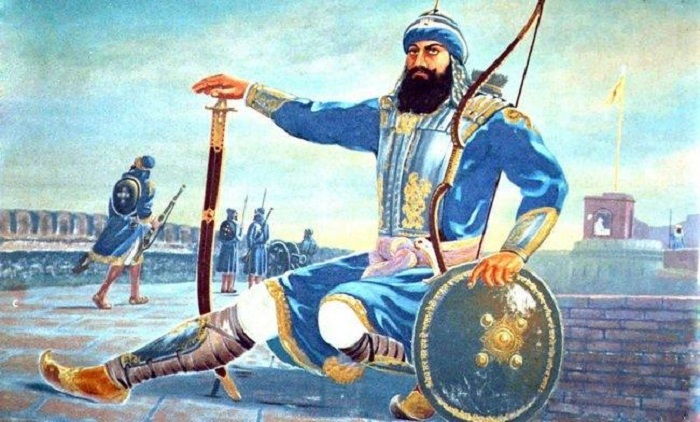Facts
Birth: 27 October 1670
Place: Rajauri, Poonch, Jammu and Kashmir
Birth name: Lachman Dev
Death: 9 June 1716
Place: Delhi, Mughal Empire
Father: Ram Dev
Mother: Sulakhani Devi
Teacher: Guru Gobind Singh
Son: Ajai Singh
Banda Singh Bahadur was a Sikh military leader, who founded a Sikh state, which had its capital at Lohgarh in present-day Haryana. As per his teacher Guru Gobind Singh’s advice, Banda Singh Bahadur assembled an army in Kaithal and then marched towards Khanda. Banda Bahadur defeated the Mughal army, led by Wazir Khan, in the ‘Battle of Samana’ (1709) and continued his struggle against the Mughal Empire. Guru Gobind Singh also appointed five Sikhs to assist Banda. Though he was a trained warrior, Banda Bahadur was also an ascetic, who had renounced worldly pleasures at the age of 15. He had even established a religious house at Nanded in present-day Maharashtra. Banda Bahadur’s popularity reached its peak when he abolished the zamindari system to subsequently bestow complete ownership on farmers. He sacked Samana and established his authority in Punjab. Banda Singh Bahadur was, however, captured by the Mughals, and tortured to death on June 9, 1716.

Image Credit : https://en.wikipedia.org/wiki/Banda_Singh_Bahadur
Childhood & Early Life
Banda Singh Bahadur was born Lachman Dev on October 27, 1670, at Rajauri, Poonch in present-day Jammu and Kashmir. Since he was born into a Rajput family, Lachman Dev learned skills like hunting, horse riding, martial arts, and handling weaponry at a very young age. Having a natural affinity with bow and arrows, he began hunting in his early teens.
When he was 15, he shot and killed a doe during one of his hunting expeditions. Moments after killing the doe, Lachman Dev realized that he had made a grave mistake as the arrow, which had pierced the doe’s body, revealed unborn twin calves that died right in front of his eyes. Upon witnessing the gory death of the unborn twin calves, Lachman wandered in search of certain answers, which forced him to leave his home and abandon worldly pleasures at the age of 15.
Lachman Dev was no stranger to saints and holy men, as his father Ram Dev had often provided food and shelter to holy men. He soon became a follower of a sadhu named Ram Daas and then followed another sadhu named Janaki Daas, who changed his name from Lachman Dev to Madho Das. Since he was a Bairagi sadhu, he came to be known as Madho Das Bairagi.
Like a true wanderer, Madho Das started moving from place-to-place, before reaching Panchavati in the present-day Nashik, Maharashtra. In Panchavati, he became a disciple of Aughhar Nath and started serving his master with utmost devotion. After serving Aughhar Nath for five years, Madho Das was blessed by Aughhar Nath, post which he developed the skill sets to perform sorcery, according to many records.
Madho Das Bairagi went on to establish a monastery at Nanded in present-day Maharashtra. He made Nanded his home and was visited by many holy men. In September 1708, the tenth Guru of the Sikhs, Guru Gobind Singh, visited his monastery, post which Madho Das became Guru Gobind Singh’s disciple. Guru Govind Singh convinced Madho that he was a Sikh and even baptized him, before giving him his new name, Gur Bakhsh Singh. Over a period of time, Gur Bakhsh Singh became famous as a military commander, earning his new name Banda Singh Bahadur, which would remain his most famous name. The name ‘Banda’ was given to him as he called himself a ‘banda’ (slave) of Guru Gobind Singh when he first met the Guru.

Image Credit : https://kulveersamra.wordpress.com/2016/07/03/the-tragedy-of-banda-bahadur/
Sikh Rule
Guru Gobind Singh convinced Banda Singh Bahadur to give up on his ascetic lifestyle to achieve something greater. He assigned Banda Bahadur an important task of freeing the innocent people of Punjab from the clutches of the Mughals as people belonging to any religion other than Islam were subjected to constant persecution by the Mughals. Also, the Mughal Emperor Bahadur Shah had earlier promised Guru Gobind Singh that he would punish Nawab Wazir Khan, the Governor of Sirhind for committing various crimes against commoners in Punjab, but the emperor was reluctant to fulfill his promise. This had enraged Guru Gobind Singh, who sought Banda Bahadur’s help to teach Wazir Khan a lesson and thereby succeed in saving many innocent lives in the process.
Guru Gobind Singh initiated him into a community of Sikh warriors called ‘Khalsa’ and appointed him as his new military commander. The Guru also summoned an advisory council of five skilled Sikhs in order to help Banda Bahadur in his endeavor. Along with the council of five Sikhs, who were collectively known as ‘Hazuri Singhs,’ Guru Gobind Singh also appointed 25 soldiers, who were to serve as bodyguards of Banda Bahadur. Also, he was given a ‘Hukamnama’ (Guru’s order), which urged all the Sikhs to join Banda Bahadur in his fight against the Mughals. In October 1708, Banda Bahadur and his men started marching towards Punjab to wage a war against Wazir Khan. Before reaching Punjab, Banda Bahadur had managed to gather an army of 40,000 men, including 4000 horsemen and 7800 men on the artillery. In 1709, he defeated the Mughal forces, led by Wazir Khan, in the Battle of Samana.
After capturing the city of Samana, the Sikhs gained access to the city’s massive wealth, which helped them become financially stable. Banda Bahadur then captured places like Mustafabad, Sadhora, Malerkotla, Nahan, and other Cis-Sutlej states of Punjab. Meanwhile, Wazir Khan, who was earlier defeated in the ‘Battle of Samana,’ returned with reinforcements, which led to the ‘Battle of Chappar Chiri’ in 1710. On May 12, Wazir Khan was killed in the battle and Sirhind, which was an important Mughal territory in Punjab, was captured by the Sikhs. The territory, which extended from River Sutlej to River Yamuna, was now under Banda Bahadur’s control. He went on to establish his capital at Mukhlisgarh, which was later renamed by him as Lohgarh.

Image Credit: https://www.indiatimes.com/news/india/here-s-everything-you-need-to-know-about-baba-banda-singh-bahadur-the-fearless-sikh-warrior-257777.html
Banda Bahadur started issuing his own mint at Lohgarh. He even sent his men to places like Saharanpur, Jalalabad, and Muzaffarnagar to bring relief to the oppressed population there. Banda Bahadur continued to expand his territory by emerging victorious against the Mughals in the ‘Battle of Rahon,’ in 1710. Banda Bahadur’s actions and bravery inspired many Sikhs to stand up and fight for their rights in places like Jalandhar and Amritsar.
Using their new-found power, the Sikhs removed corrupt officials from important positions and replaced them with upright officials. Banda Bahadur also put an end to the zamindari system and bestowed complete ownership on farmers, which made him very popular.
He was approached by the people from the neighboring city of Sadaura for his help. This led to the ‘Battle of Sadhaura,’ in which the Sikhs overpowered the Sayyids and Shaikhs to free hundreds from the clutches of their evil landlords.

Image Credit : http://www.sikh-history.com/sikhhist/warriors/banda.html
Mughal Persecution
When Punjab came under the control of the Sikhs, the route between Delhi and Lahore was obstructed, which did not go down well with the Mughal Emperor Bahadur Shah. Hence, he decided to deal with Banda Bahadur himself and directed his generals to join his army to defeat and kill Banda Bahadur. When Banda Bahadur was in Uttar Pradesh, the Mughal army led by Munim Khan captured Sirhind and the surrounding areas. However, the Mughals failed to capture Banda Bahadur, which caused great concern to Bahadur Shah. After Bahadur Shah’s demise on February 27, 1712, Farrukh Siyar became the Mughal Emperor after killing Bahadur Shah’s successor, Jahandar Shah. Farrukh Siyar took up Bahadur Shah’s unfinished mission of capturing Banda Bahadur. Hence, he appointed Abdus Samad Khan as the governor of Lahore, hoping Samad Khan’s army would be able to subdue Banda Bahadur’s forces. In March 1715, Abdus Samad Khan and his army were successful in driving Banda Bahadur and his men into a village called Gurdas Nangal. They then laid siege to the entire village for eight consecutive months, which weakened Banda Bahadur and his army. Abdus Samad Khan, who had been waiting for the right moment, decided to lead his forces into the village on December 7, 1715, and managed to capture Banda Bahadur and his men.

Image Credit :https://sikhunity.wordpress.com/2014/01/02/bibi-susheel-kaur-jee-wife-of-baba-banda-singh-bahadur/comment-page-1/
Execution
Banda Singh Bahadur and his men were locked up and tortured by the Mughal soldiers. The torturers gave Banda and his men two options – convert to Islam or face death. When Banda’s men refused to convert, they were tortured and killed in public. After undergoing various torture and humiliation during his confinement period of three months, Banda Singh Bahadur was executed on June 9, 1716. Various records state that Banda was tortured beyond imagination before his death. These records state that his eyes were gouged out, limbs severed, and skin peeled using red-hot pincers. Banda’s only son Ajai Singh was also killed brutally by the Mughals.
Legacy
The death of Banda Singh Bahadur enraged many Sikh warriors, who vowed to carry forward the legacy of Banda Bahadur by standing up for their rights. Warriors like Sardar Budh Singh, Nawab Kapur Singh, and Baba Deep Singh kept the torch of the Khalsa burning, which played a major role in Sikhs dominating the region of Punjab. Years later, Fateh Burj, which is India’s tallest minar, was built to honor Banda Singh Bahadur and his sacrifice. In 2016, India’s Prime Minister Narendra Modi commemorated Baba Banda Singh Bahadur’s 300th martyrdom anniversary.


